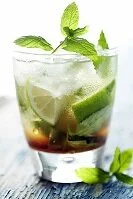Regional Variations, Specialties, & Unique Dishes
Arroz con Pollo: rice based dish with chicken and often cooked with tomatoes and Spanish spices
Mixto (or Cuban Sandwich): a pressed sandwich on bread with pork, ham, Swiss cheese, pickles and mustard
Paella: baked rice dish with various seafood, onions, and peppers
Tamales: the Cuban version is pork in corn dough, then boiled
Dining Etiquette
The Cubans have many of the same dining rules as the Central American countries and the level of formality of a meal is more dependent on the company and restaurant than anything else.
As you enter a home or restaurant, the men should hold the door open for women and let "senior" men enter a room before themselves. If eating in a nice restaurant or a local's home dress a little nicer than you otherwise would, especially if dining with a business colleague. Try to arrive on time, but remember many locals will arrive up to 15 minutes late.
Your host will show you your seat and if you are with your significant other you may be separated to stimulate greater conversation, after all dining together is meant to be a social event in Cuba. The meal may begin with a toast, the most common toast being "salud" and the meal will begin with the words "buen provecho."
While eating use the continental style (knife in the right hand, fork in the left) for all foods, including fruits, and keep your hands in sight be resting your wrists on the edge of the table. Once you are finished eating place your fork and knife together on the right side of your plate to indicate you are finished. A meal may end with coffee and more conversation and it is considered rude to leave right after dinner if your hosts invite you to stay.
If dining in a restaurant get the server's attention by making eye contact, don't wave or call his/her name. The inviter is expected to pay for everyone present, but all others should make an effort to help pay. If you are paying, tips are not expected, but if in a resort, a high end restaurant, or just if service was excellent you may tip a small amount (about $1 or €1), but hand it directly to the server.
Celebrations & Events
The one holiday closely associated with particular foods in Cuba is Christmas. Christmas, or Christmas Eve is highlighted by a roasted pig, beans, bread, and an incomprehensible number of desserts. Generally though this celebration, which can last a full week, is reserved for family and the vastness of the food is only dictated by the size of the family.
For other celebratory events in Cuba, like anniversaries or birthday, the foods vary a bit, but tend to have a huge number of desserts again. Cake is usually only served for birthdays, but other sweets and desserts are common for all events and celebrations.
Drinks

Mojito
Drinks in Cuba are common, but there's a preference for local drinks over international, especially over American beverages. Coffee is the drink of choice for most locals in the morning, but local colas, including "Cachito" and "Tu Cola" are more popular for a leisurely drink. Juices are not as common in much of the country as they are elsewhere in the Caribbean, but still easily accessible on market shelves. For a more unique and unusual drink seek out "guarapo," which is the juices from pressed sugarcane, but it is incredibly sweet.
Mixed alcoholic drinks are the drink of choice when consuming alcohol and the options are nearly endless. Rum is the most popular alcohol, but the mixed drinks vary widely, including well-known drinks like daiquiris, mojitos, and rum and coke (known in Cuba as a Cuba Libre). Beers are also common and there are numerous local brews to choice from including Cristal and Bucanero.
The tap water is generally safe to drink in Cuba, however confirm this with your hotel or guesthouse, particularly during hurricane season as the water can be contaminated. If you do drink the water, many people may have trouble adjusting to the local tap water, as it will most certainly be different from what your system is used to if you are not from the region.